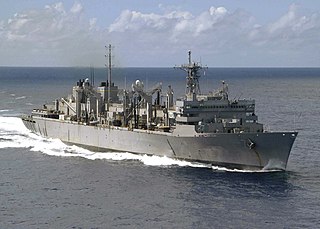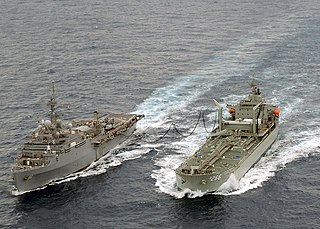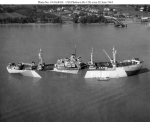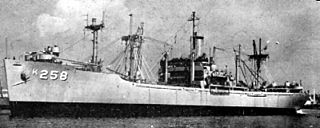
The fast combat support ship is a type of replenishment auxiliary ship. Different from traditional logistic ships, the fast combat support ship is designed with high speed to keep up with the carrier battle group/carrier strike group, while the multi-product station is capable of supplying all types of necessities for the fleet.

Combat stores ships, or storeships, are ships used to store naval supplies. They are used to deliver supplies such as provisions and fuel to combat ships on extended deployments. The United States Navy operated the Sirius and Mars classes and the Royal Navy operated the Fort Rosalie class and continues to operate one Fort Victoria class ship, having scrapped the other. They carried or carry the fleets's refrigerated stores, dry provisions, technical spares, general stores, fleet freight, mail and replacement personnel\specialists. Storeships should not be confused with fast combat support ships which are high speed auxiliary ships or tenders which provide maintenance support to flotillas.

A replenishment oiler or replenishment tanker is a naval auxiliary ship with fuel tanks and dry cargo holds which can supply both fuel and dry stores during underway replenishment (UNREP) at sea. Many countries have used replenishment oilers.

USS Rainier (AE-5), the second US Navy vessel named after Mount Rainier, was laid down on 14 May 1940 by the Tampa Shipbuilding Co., Tampa, Fla., as Rainbow ; launched 1 March 1941; sponsored by Mrs. Robert E. Anderson; transferred to the US Navy on 16 April 1941; converted for use as an ammunition auxiliary; and commissioned as Rainier (AE-5) on 21 December 1941 at Norfolk, Va..

The second USS Seattle (AOE-3), a Sacramento-class fast combat support ship, was laid down on 1 October 1965, at the Puget Sound Naval Shipyard, Bremerton, Washington; launched on 2 March 1968; sponsored by Mrs. William M. Allen, chairman of the board of the Children's Orthopedic Hospital Association, Seattle; and commissioned on 5 April 1969.

Replenishment at sea (RAS) or underway replenishment (UNREP) is a method of transferring fuel, munitions, and stores from one ship to another while under way. First developed in the early 20th century, it was used extensively by the United States Navy as a logistics support technique in the Pacific theatre of World War II, permitting U.S. carrier task forces to remain at sea indefinitely.

USS Sylvania (AFS-2), a Mars-class combat stores ship, was the second ship of the United States Navy to be named Sylvania.

USS Niagara Falls (AFS–3), a Mars-class combat stores ship, was the only ship of the United States Navy to be named after the City of Niagara Falls, New York. Commissioned into the US Navy on 29 April 1967, she served until September 1994, when she was transferred to the US Military Sealift Command to serve as USNS Niagara Falls (T-AFS-3). Assigned to the Naval Fleet Auxiliary Force, Far East, she served until 30 September 2008, when she was finally deactivated.

USS Graffias (AF-29), a Hyades-class stores ship, is the only ship of the United States Navy to have this name. The name Graffias is another name for the star Beta Scorpii in the constellation Scorpius.

USS Warrick (AKA-89) was an Andromeda-class attack cargo ship in service with the United States Navy from 1944 to 1957. She was sunk as a target in 1971.

USS Alcyone (AKA-7) was an Arcturus-class attack cargo ship named after Alcyone, the brightest star in the star cluster Pleiades. She served as a commissioned ship for five years and one month.

USS Wabash (AOR-5) was a Wichita-class replenishment oiler in the United States Navy from 1970 to 1994.

USS Polaris (AF-11) was a Type C2 "Liberty fleet" standard freighter and an Aldebaran-class stores ship acquired from the United States Maritime Commission by the US Navy for World War II and the Korean War. She was launched in 1939 at Sun Shipbuilding & Drydock Co., Chester, Pennsylvania.

USS Phobos (AK-129) was a Crater-class cargo ship commissioned by the U.S. Navy for service in World War II. She was responsible for delivering troops, goods and equipment to locations in the war zone.

USS Ascella (AK-137) was a Crater-class cargo ship commissioned by the US Navy for service in World War II. Ascella was named after Ascella, a star in the constellation Sagittarius. She was responsible for delivering troops, goods and equipment to locations in the Asiatic-Pacific Theater.

USS Hyades (AF-28) was the lead ship of her class of stores ships acquired by the U.S. Navy for service in World War II. Her task was to carry stores, refrigerated items, and equipment to ships in the fleet and to remote stations and staging areas.

USS Alstede (AF-48) was an Alstede-class stores ship acquired by the U.S. Navy at the end of World War II. Her task was to carry stores, refrigerated items, and equipment to ships in the fleet, and to remote stations and staging areas.

USS Vega (AF-59) was a Rigel-class stores ship acquired by the U.S. Navy. Her task was to carry stores, refrigerated items, and equipment to ships in the fleet, and to remote stations and staging areas. She served during the entire Vietnam War and returned home with numerous battle stars and commendations.

The second USS Antares (AK-258) was a United States Navy Greenville Victory-class cargo ship in commission from 1952 to 1959. She was converted into a general stores issue ship (AKS-33) in 1959-1960 and remained in commission as such until 1964. She saw extensive service during the Cold War. Prior to her U.S. Navy career, she had operated as the merchant ship SS Nampa Victory during the latter stages of World War II and in the years immediately after the war.


















